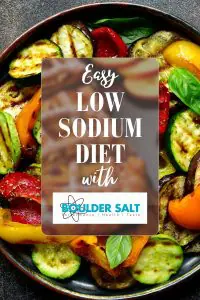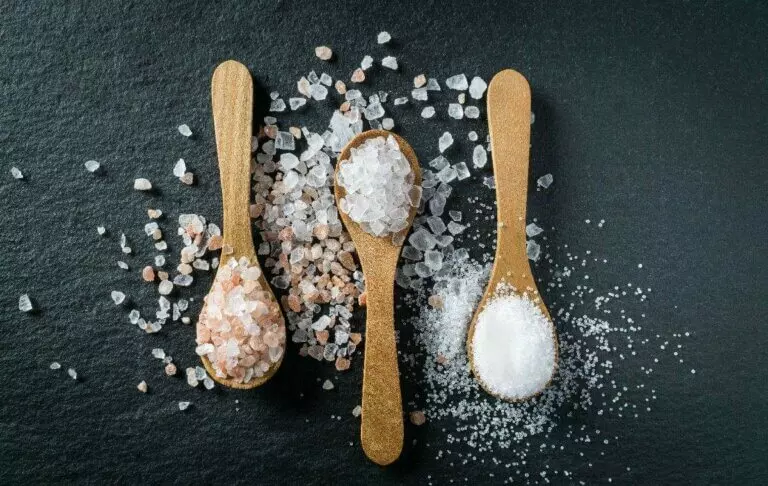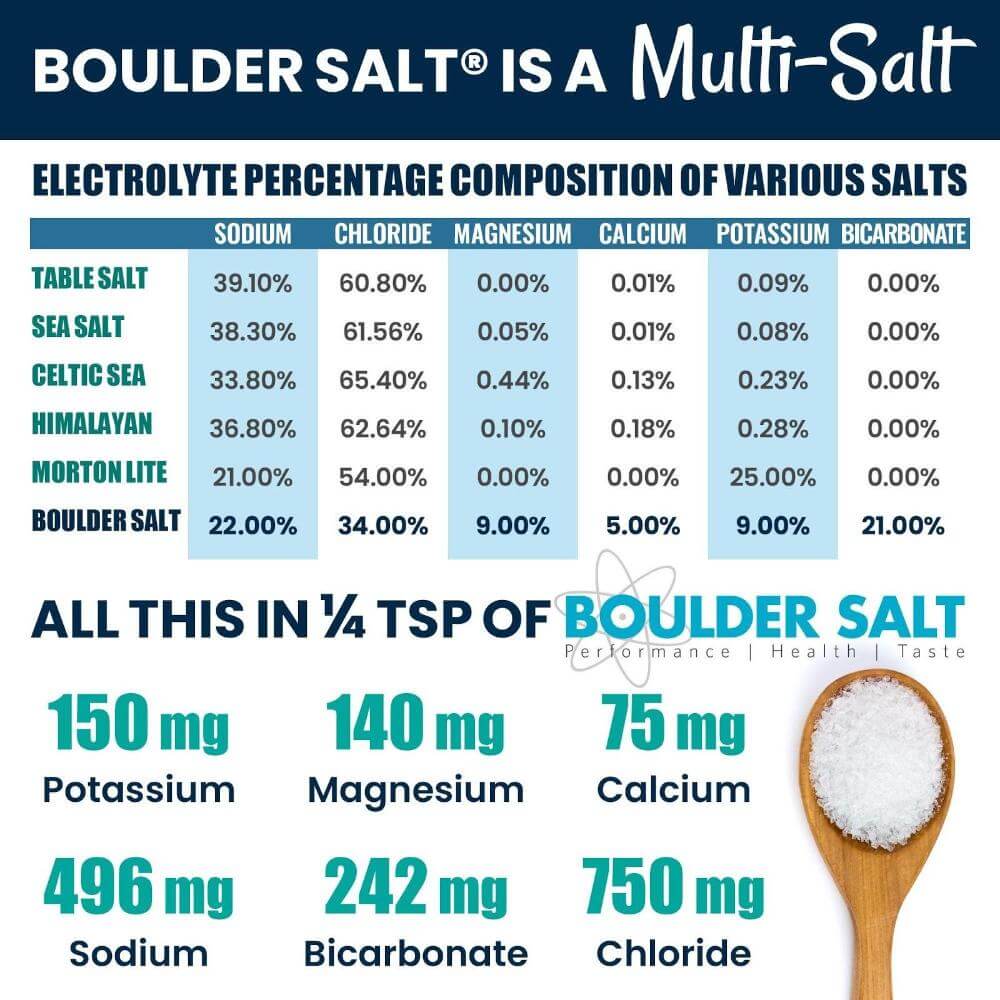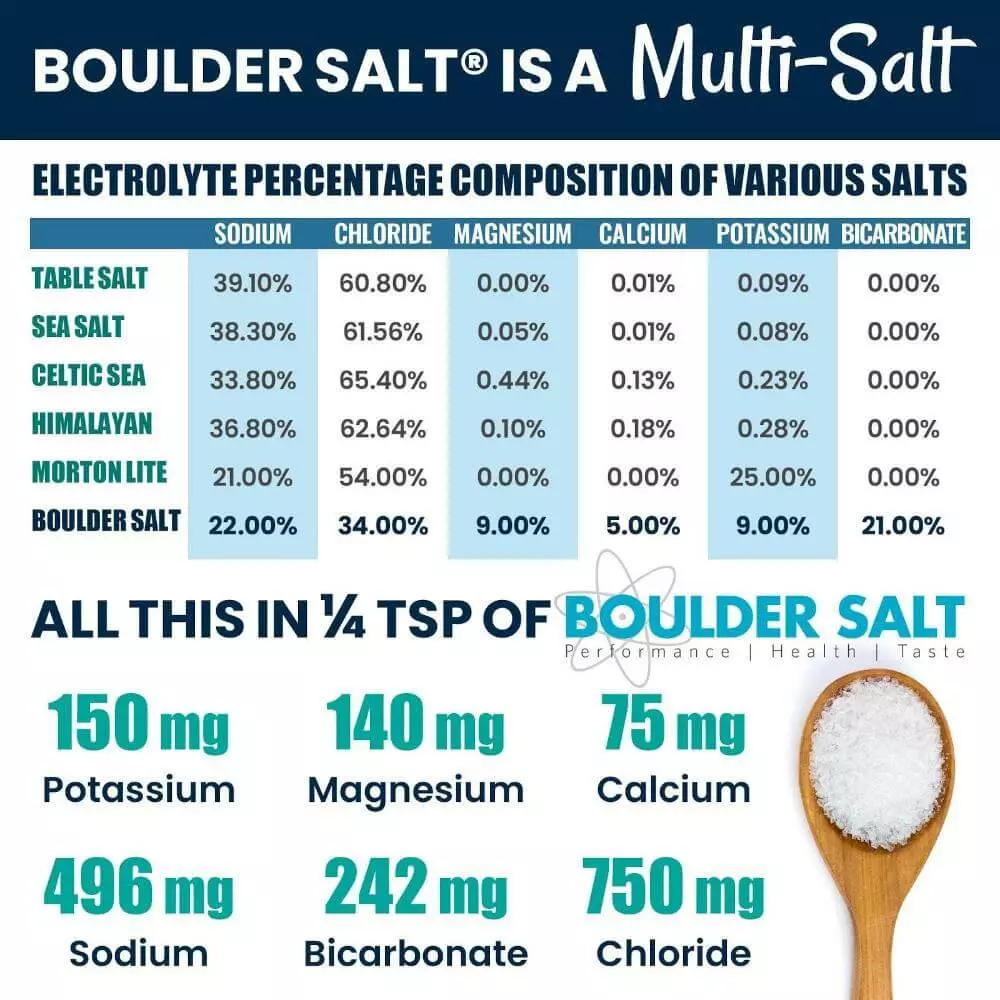
Low Sodium Diet Ideas Any Diet is Low Sodium with Boulder Salt! Are you looking for low sodium diet ideas and recipes

In a bygone era buying salt was one of the simplest purchases you could make – you could buy salt made of sodium chloride or…you could buy salt made of sodium chloride! Over the past 50 years or so more and more people have sought to replace or upgrade from the old standby. In response, countless alternatives to traditional table salt (which had gone largely unchallenged and unchanged for centuries), have been brought to market. Many types of salt that used to be considered exotic or unusual have become commonplace. Himalayan salt, pink salt, sea salt, Celtic Sea Salt, Lite salt(™), salt substitutes, no salt(R) are just a few of these. While some of the relative newcomers are popular and offer a variety of colors, flavors, and other characteristics, only one of them represents a significantly more healthy salt than plain-old traditional white table salt.
How can you “keep it simple” as you choose from the multitude of salts available these days?
Focus on three key characteristics when buying salt: taste, health, and (hydration/performance). A good salt should taste good on food, have meaningful levels of all electrolytes, be free of known dangerous contaminants, and taste good in water (for hydration and physical performance).
While a review of ingredients can, with some accuracy, forecast how good a salt will taste…it’s ultimately up to each individual to decide “what’s good”. That said, it’s worth noting that, in addition to being the healthiest salt you can find, Boulder Salt was chosen by 32 of 40 participants in a blind taste test! It’s ultimately up to you to evaluate the taste when buying salt.
Let’s start with health/nutrition. It’s the quality that grew the most in importance to salt lovers as the nutritional shortcomings of traditional table salt gradually became more apparent. The greatest achievable improvement however, is not “low sodium”, or “less sodium”. The key to buying salt is to look for balance, not just “low sodium”. The best salt has substantial amounts of magnesium, potassium, and calcium alongside the sodium it contains. It is also alkaline. It is called Boulder Salt. If health is your primary consideration when buying salt, consider Boulder Salt!
While athletes/outdoor workers/factory workers have sometimes used traditional white table salt in water for hydration, it provided limited benefit because its electrolyte levels are not in a balanced ratio. Because it has some drawbacks, it has been seen as unhealthy. To limit our sodium intake we are advised to eat salt in moderation. It is portrayed as a “guilty pleasure”. Until now, “ but there’s a more important question than that: “What kind of salt should we eat?” There are many discussions among health experts and professionals concerning the health benefits of the right kind of salt.
Unrefined salts (grey, pink, black, etc) contain contaminants, some of which are healthy and some quite toxic. The healthiest salt is actually a blend of white salts (sodium, potassium, magnesium, calcium, and bicarbonate) that you can be comfortable knowing are very low in the most dangerous contaminants (lead, cadmium, mercury, arsenic) and are then blended together in a specific ratio that still tastes good. There can be many disadvantages to eating unrefined/impure salt. There are no benefits, given the low levels of other electrolytes (see table below). The correct use of high purity ingredients, in meaningful ratios, is how the best salt is created. Keep that in mind when buying salt.
Color in a salt indicates impurities are present. Some of these are harmful and some are not. Iron and potassium may be present in the coloring, but rarely in meaningful levels. Lead, mercury, cadmium, and arsenic are often present in colored salts, and especially lead in pink salts. (see https://www.mdpi.com/2304-8158/9/10/1490 for 2020 Australian study of multiple brands of pink salt, with some having dangerously high levels of lead (>2.0mg/kg).
To learn more…and where to buy salt
You can find many brands and types of unrefined salt at various prices. You can find in-depth analysis of benefits and drawbacks of many salt types on our blog.
Where to learn about Boulder Salt…www.bouldersaltcompany.com
Where to buy salt (Boulder Salt)…www.bouldersaltcompany.com/shop/
How does your salt compare? With such a balanced electrolyte profile, Boulder Salt has gone beyond just salt. It represents a new category. It is a multi-salt.


More to explore

Low Sodium Diet Ideas Any Diet is Low Sodium with Boulder Salt! Are you looking for low sodium diet ideas and recipes

Mountain View Welding does excellent work!
We make the highest recommendation for Loren Tonsing and the staff at https://mountainviewwelding.com Mountain View Welding does excellent work! Excellent communication to

Boulder Salt is in stock at The Raw Store!
Where in the world is Boulder Salt? This time the news is that Boulder Salt is stocked at The Raw Store in